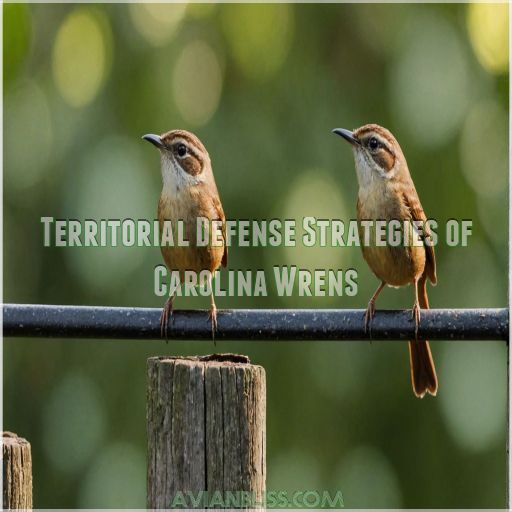This site is supported by our readers. We may earn a commission, at no cost to you, if you purchase through links.
 Yes, Carolina wrens are fiercely territorial!
Yes, Carolina wrens are fiercely territorial!
These feisty little birds don’t just defend their turf during breeding season—they’re territorial titans year-round.
You’ll find them passionately guarding their 2-10 acre domains against any feathered intruders.
Both male and female wrens team up to protect their patch, using a repertoire of vocal acrobatics and physical displays.
Their signature "teakettle-teakettle" song isn’t just for show; it’s a bold declaration of ownership.
While other wrens might take a winter break from territory defense, Carolina wrens stand guard 24/7, 365 days a year.
It’s as if they’ve signed a lifetime lease on their chosen real estate!
Table Of Contents
- Key Takeaways
- Carolina Wrens: Territorial Behavior Explained
- Territorial Defense Strategies of Carolina Wrens
- Year-Round Territoriality in Carolina Wrens
- Effects of Territoriality on Carolina Wren Population
- Managing Carolina Wren Territoriality in Human Environments
- Frequently Asked Questions (FAQs)
- Are Carolina Wrens aggressive to other birds?
- Do Carolina Wrens stay in the same area?
- How territorial are wrens?
- Are wrens a good bird to have around?
- Do Carolina Wrens fight with other bird species?
- How large is a typical Carolina Wren territory?
- Can multiple Carolina Wren pairs share territories?
- Do juvenile Carolina Wrens establish their own territories?
- How do urbanization and habitat fragmentation affect territoriality?
- Conclusion
Key Takeaways
- You’ll find these feisty little birds defending their turf year-round, not just during breeding season. They’re like miniature security guards, always on duty and ready to chase off intruders from their 2-10 acre domains.
- You’ll hear carolina wrens before you see them – their loud "teakettle-teakettle" song isn’t just for show. It’s their way of saying "This is my yard, buddy!" to any feathered trespassers who dare to enter their territory.
- You might be surprised to learn that both male and female Carolina wrens team up to protect their patch. They’re the power couple of the bird world, using a combination of vocal acrobatics and physical displays to keep their home safe.
- You’ll notice Carolina wrens don’t take winter vacations from guarding their turf. While other wrens might slack off during the cold months, these pint-sized patrollers stay vigilant 24/7, 365 days a year. It’s as if they’ve signed a lifetime lease on their chosen real estate!
Carolina Wrens: Territorial Behavior Explained
You’re about to uncover the fierce world of Carolina Wrens and their territorial antics.
These pint-sized powerhouses defend their turf with gusto, and we’ll explore why they’re so protective, how they stake their claim, and what makes their territorial behavior unique among their feathered friends.
Definition of Territorial Behavior in Birds
When you look at birds, you’ll find territorial behavior is like setting up invisible "No Trespassing" signs.
It’s how our avian friends stake their claim, defending resources and mates from would-be intruders.
Reasons for Territorial Behavior in Carolina Wrens
Carolina Wrens’ territorial nature stems from their need to secure essential resources.
You’ll find these feisty birds fiercely guarding their turf for food, mates, and nesting spots.
It’s their way of ensuring survival in a competitive avian world.
Seasonal Variations in Territorial Behavior
Throughout the year, you’ll notice Carolina Wrens’ territorial drive shifting gears.
During breeding season, they’re on high alert, fiercely guarding nests.
Come winter, they’ll still defend their turf, but with less intensity as food becomes the priority.
Comparison With Other Wren Species’ Territoriality
You’ll find Carolina Wrens stand out among their feathered cousins in terms of territorial behavior.
Unlike other wrens, they fiercely defend their turf year-round.
While species like House Wrens only get territorial during breeding season.
Impact of Habitat on Territorial Behavior
While other wrens may adapt differently, Carolina Wrens’ territorial behavior is deeply influenced by their surroundings.
Their feisty nature shines through in various habitats:
- Dense undergrowth
- Suburban backyards
- Open woodlands
- Brushy edges
These little warriors fiercely defend their chosen turf!
Territorial Defense Strategies of Carolina Wrens
You’re about to discover the fierce world of Carolina Wren territorial defense.
From their piercing songs to their bold posturing, these tiny titans employ a range of strategies to protect their turf that’ll leave you amazed at their tenacity.
Vocal Displays and Song Patterns
Carolina Wrens are the vocal virtuosos of the bird world, known for their territorial defense. They use an impressive array of sounds to defend their turf. Let’s explore their melodious arsenal:
| Sound Type | Description | Purpose |
|---|---|---|
| Song | Loud "tea-kettle" | Territory claim |
| Duet | Male leads, female joins | Pair bonding |
| Alarm call | Sharp "chirp" | Warn of threats |
| Chatter | Rapid series of notes | Aggressive warning |
These feisty birds aren’t shy about belting out their tunes. You’ll often hear them before you see them!
Physical Displays and Posturing
Beyond their vocal prowess, Carolina Wrens employ a range of physical displays to assert dominance:
- Tail-feather ruffling
- Wing-fluttering
- Head-bobbing
- Bill-pointing
- Body-puffing
These feisty birds put on quite a show when defending their turf!
Aggressive Encounters With Intruders
You’ve seen their posturing, but what happens when intruders push their luck?
Carolina Wrens don’t mess around. They’ll chase off rivals with fierce determination, swooping and pecking to protect their turf.
It’s a feathered frenzy!
Territory Size and Boundaries
Having witnessed those fierce encounters, let’s explore the Carolina Wren’s territory size. These tiny titans defend areas ranging from 2 to 10 acres, depending on:
- Lush vegetation density
- Abundant insect buffets
- Prime nesting real estate
- Neighboring wren populations
Role of Male and Female in Territory Defense
Both male and female Carolina Wrens are fierce defenders of their turf.
While the male’s booming "tea-kettle" song warns off intruders, his partner’s not just sitting pretty.
She’s right there with him, ready to rumble.
Year-Round Territoriality in Carolina Wrens
You might think Carolina Wrens take a break from their territorial ways, but these feisty birds are on guard all year round.
Let’s uncover the secrets behind their unwavering defense and how it shapes their lives through every season.
Permanent Pair Bonding and Territory Maintenance
Unlike many birds, Carolina wrens stick together year-round.
You’ll find these feathered lovebirds maintaining their territory through thick and thin.
Their unwavering bond guarantees prime real estate for nesting and foraging, giving them a leg up in survival.
Winter Territoriality and Survival Strategies
During winter’s chill, Carolina Wrens don’t let their guard down.
You’ll find these feisty birds fiercely defending their territories year-round.
They’re constantly on the lookout for food, safe roosting spots, and potential threats, adapting to harsh conditions with remarkable resilience.
Breeding Season Territorial Intensity
You’ll notice Carolina Wrens kick their territorial drive into high gear during breeding season.
They’re not just protecting real estate anymore—it’s all about nest defense, brood protection, and mate guarding.
Talk about fierce feathered families!
Territory Defense During Non-breeding Months
The feisty Carolina Wren doesn’t take winter vacations from guarding its turf. Even in chilly months, these pint-sized patrollers stay vigilant. Here’s how they defend year-round:
- Vocal volleys
- Food cache protection
- Nest site safeguarding
- Boundary patrols
Factors Influencing Year-round Territorial Behavior
Now let’s uncover what keeps Carolina Wrens on high alert year-round. These feisty birds don’t take vacations from guarding their turf!
Food availability, habitat size, prime nest sites, and predator pressure all play starring roles in their 24/7 territorial drama.
Effects of Territoriality on Carolina Wren Population
You’ve seen how fiercely Carolina Wrens defend their turf, but have you ever wondered how this impacts their population?
Let’s uncover how these feisty birds’ territorial nature shapes their numbers, influences their love lives, and even drives their species’ expansion into new areas.
Impact on Population Density and Distribution
Carolina Wrens’ fierce territoriality shapes their world.
Ever wonder why you’ll spot these feisty birds in some areas but not others?
Their territorial nature directly impacts where they set up shop and how many can cozy up in a given space.
Role in Mate Selection and Pair Bonding
Frequently, you’ll find that a wren’s territorial prowess plays cupid.
Their song and courtship rituals, intertwined with fierce territory defense, create a love story amid the foliage.
It’s like nature’s own matchmaking service for these feisty little birds.
Influence on Breeding Success and Offspring Survival
You’ll find that a Carolina Wren’s fierce territory defense isn’t just for show.
It’s their ticket to reproductive success.
By guarding prime real estate, these feisty birds help secure better nest sites, reduced predation risk, and more food for their chicks.
Territorial Behavior and Range Expansion
The territorial nature of Carolina Wrens plays a fascinating role in their range expansion.
Carolina Wrens claim new turf, pushing northward, adapting to urban areas, and weathering climate shifts with their fierce determination.
Competition With Other Bird Species
As Carolina Wrens expand their range, they’re not just battling each other. These feisty birds face off with various species for prime real estate and snacks. Here’s how they handle the competition:
- Food fight: Challenging larger birds at feeders
- Nest nabbing: Outmaneuvering competitors for cozy cavities
- Turf wars: Defending territory against similar-sized songbirds
- Vocal victories: Out-singing rivals to claim the best spots
Managing Carolina Wren Territoriality in Human Environments
If you’ve got Carolina Wrens setting up shop in your backyard, you’re in for a treat – and maybe a bit of a challenge.
Wren-friendly haven while keeping the peace between these feisty birds and their feathered neighbors.
Creating Suitable Habitats for Territorial Pairs
| Habitat Element | Purpose | Implementation |
|---|---|---|
| Brush piles | Shelter | Stack branches |
| Native plants | Food | Plant berries |
| Water features | Hydration | Install birdbath |
| Dense shrubs | Nesting | Prune sparingly |
Nest Box Placement and Territory Considerations
When placing nest boxes for Carolina Wrens, consider their territorial nature when choosing a location.
Space boxes at least 100 feet apart to respect boundaries and reduce competition.
Opt for designs with slots rather than holes, mimicking their preferred natural cavities.
You’ll be a wren’s best friend!
Mitigating Conflicts With Other Backyard Birds
You’ve got three feathered strategies to keep the peace in your backyard bird kingdom.
First, spread out your feeders.
Second, diversify your food offerings.
Observing and Appreciating Territorial Behaviors
- Listen for their distinctive "tea-kettle" song
- Watch for energetic foraging in pairs
- Spot their upward-cocked tails
- Notice their bold defense of nest boxes
Conservation Implications of Carolina Wren Territoriality
Territorial behaviors of Carolina Wrens have significant conservation implications.
Let’s explore how their fierce defense strategies impact habitat management and population dynamics.
| Factor | Impact | Conservation Approach |
|---|---|---|
| Habitat fragmentation | Reduces available territories | Preserve connected green spaces |
| Climate change | Alters breeding patterns | Monitor range shifts, provide adaptable habitats |
| Human-wildlife conflict | Increases competition for resources | Design wildlife-friendly landscapes |
Frequently Asked Questions (FAQs)
Are Carolina Wrens aggressive to other birds?
Like tiny feathered knights, Carolina Wrens fiercely defend their castle.
They’re not typically aggressive to other birds, but they’ll boldly stand their ground if another species encroaches on their territory.
You’ll see them chase intruders away confidently.
Do Carolina Wrens stay in the same area?
Carolina Wrens are homebodies at heart. You’ll find these feathered friends sticking close to their chosen territory year-round.
They’re not ones for wanderlust, preferring to defend their turf with gusto rather than explore new horizons.
How territorial are wrens?
Feisty and fierce, wrens defend their domains with gusto.
You’ll witness these tiny titans tirelessly patrolling their turf, belting out bold ballads to ward off intruders.
They’re not just territorial – they’re the feathered fortresses of the backyard!
Are wrens a good bird to have around?
You’ll enjoy having wrens around!
They’re lively bug-eaters, serenading you with beautiful songs.
Their curious nature adds charm to your yard.
Just provide some shelter and watch these feathered friends bring life to your outdoor space.
Do Carolina Wrens fight with other bird species?
Like tiny feathered warriors, these vocal virtuosos fiercely defend their turf.
You’ll witness them squabbling with other birds, especially during breeding season.
They’re not bullies, though – just passionate about protecting their slice of avian paradise.
How large is a typical Carolina Wren territory?
Carolina Wrens fiercely defend their year-round territories, typically spanning 3-10 acres.
You’ll find these feathered homeowners patrolling their turf with gusto, singing their hearts out to warn off intruders.
It’s quite the avian real estate market!
Can multiple Carolina Wren pairs share territories?
Did you know a captive male Carolina Wren sang nearly 3,000 times in one day?
That’s dedication!
These feathered friends don’t play well with others, though.
They’re fiercely territorial, sticking to their own turf year-round.
Do juvenile Carolina Wrens establish their own territories?
You’ll find that young Carolina Wrens don’t immediately stake out their own turf.
They’ll typically hang around their parents’ territory for a while, learning the ropes before venturing off to establish their own domain.
How do urbanization and habitat fragmentation affect territoriality?
A bird in the hand is worth two in the bush." You’re witnessing nature’s balancing act.
Urbanization and habitat fragmentation can intensify territorial behaviors, as wrens adapt to smaller, isolated spaces.
They’re resilient little fighters, aren’t they?
Conclusion
Remarkably, Carolina wrens maintain their territories 365 days a year, a feat unmatched by many other bird species.
Carolina wrens are fiercely territorial, defending their turf with gusto.
Whether you’re a bird enthusiast or a casual observer, understanding that Carolina wrens are territorial can enhance your appreciation of these feathered fighters.
Next time you hear that distinctive "teakettle-teakettle" call, remember: you’re witnessing a tiny titan proclaiming its domain. Who knew such a small bird could have such a big personality?








